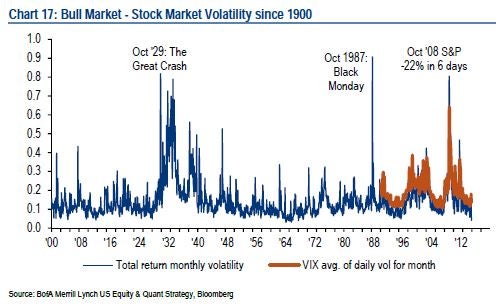In the years since the financial crisis, policy makers worldwide have fought a constant battle against deflation. According to a recent report by Bank of America, “monetary ammo is now close to exhaustion.” It’s unclear how this war against deflation will play out during the rest of 2015, but here are 10 charts that show how things have gone so far.
The first chart shows how global interest rate cuts have supported and boosted equity markets.

Even after massive government stimulus since the Great Financial Crisis, U.S. GDP growth remains historically low.

U.S. policy makers have taken measures to be more fiscally responsible in recent years, but the country remains extremely high-leveraged by historical standards.

The U.S. monetary base has grown by a staggering rate in the past decade during the Federal Reserve’s three quantitative easing programs.

The housing market in the U.S. has recovered In recent years. Its crash was the root of the financial crisis.

Bank of America sees a recovery in the U.S. labor participation rate in 2015, which is at its lowest level since about 1978.

Lower oil prices have been devastating for the U.S. oil industry, but it has been an additional stimulus for most of the rest of the economy.

Bank of America is predicting rising bond yields in 2015, but analysts still believe stocks will outshine bonds for the year.

An uptick in the relative performance of banks versus the S&P 500 would be an indication that the economy is winning the war against deflation.

Bank of America sees volatility, the U.S. dollar, and gold as big winners in 2015.

For now, the war against deflation wages on. Although there are early signs that the global economy is close to victory, it has come at a heavy price.
Read this article and all my other articles for free on Benzinga by clicking here
Want to learn more about the stock market? Or maybe you just want to be able to look sophisticated in front of your coworkers when they ask you what you are reading on your Kindle, and you’d prefer to tell them “Oh, I’m just reading a book about stock market analysis,” rather than the usual “Oh, I’m just looking at pics of my ex-girlfriend on Facebook.” For these reasons and more, check out my book, Beating Wall Street with Common Sense. I don’t have a degree in finance; I have a degree in neuroscience. You don’t have to predict what stocks will do if you can predict what traders will do and be one step ahead of them. I made a 400% return in the stock market over five years using only basic principles of psychology and common sense. Beating Wall Street with Common Sense is now available on Amazon, and tradingcommonsense.com is always available on your local internet!

